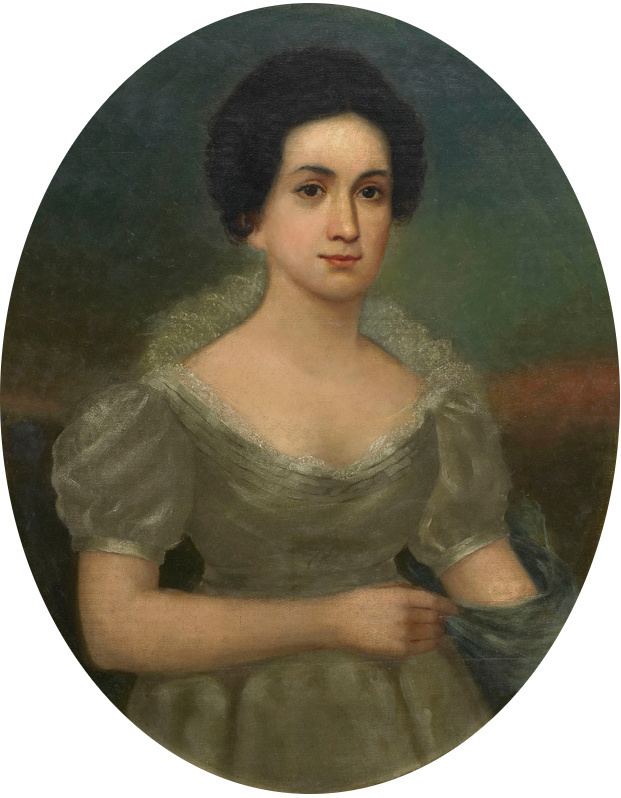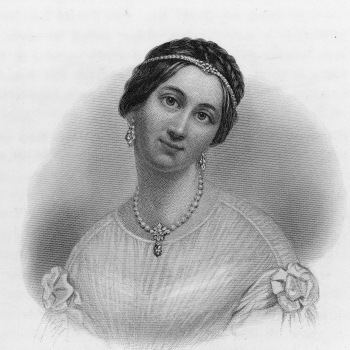Name Julia Tyler | Signature | |
 | ||
Born May 4, 1820Gardiner's Island, New York, U.S. ( 1820-05-04 ) Children Lyon Gardiner Tyler, David Gardiner Tyler Parents Juliana McLachlan-Gardiner, David Gardiner Siblings Alexander Gardiner, Margaret Gardiner Similar People | ||
Julia Gardiner Tyler (May 4, 1820 – July 10, 1889) was the second wife of John Tyler, who was the tenth President of the United States, and served as First Lady of the United States from June 26, 1844, to March 4, 1845.
Contents
- Early life
- Courtship with President Tyler
- First Lady of the United States
- Later life
- Personal life
- Legacy
- References

Early life

Julia Gardiner Tyler was born in 1820 on New York's Gardiner's Island, one of the largest privately owned islands in the United States. She was the daughter of David Gardiner, a landowner and New York State Senator (1824 to 1828), and Juliana MacLachlan Gardiner. Her ancestry was part Dutch, part Scottish and part English.

She was raised in the town of East Hampton and the small hamlet of Bay Shore, and educated at the Chegary Institute in New York. In 1839, she shocked polite society by appearing, posed with an unidentified man and identified as "The Rose of Long Island", in a newspaper advertisement for a middle-class department store. Her family took her to Europe to avoid further publicity and allow her notoriety to subside. They first left for London, arriving on October 29, 1840. They visited England, France, Italy, Switzerland, Germany, Holland, Belgium, Ireland and Scotland before returning to New York in September 1841.
Courtship with President Tyler
On January 20, 1842, the 21-year-old Julia was introduced to President John Tyler at a White House reception. After the death of his first wife, Letitia Christian Tyler, on September 10, 1842, Tyler made it clear that he wished to get involved with Julia. Initially the high-spirited and independent-minded northern beauty felt little attraction to the grave, reserved Virginia gentleman, who was thirty years her senior. He first proposed to her on February 22, 1843, when she was 22, at a White House Masquerade Ball. She refused that and later proposals he made. The increased time spent together prompted public speculation about their relationship.
Julia, her sister Margaret, and her father joined a Presidential excursion on the new steam frigate Princeton. David Gardiner, along with a number of others, lost his life in the explosion of a huge naval gun called the Peacemaker. Julia was devastated by the death of her adored father. She spoke often in later years of how the President's quiet strength sustained her during this difficult time. Tyler comforted Julia in her grief and won her consent to a secret engagement, proposing in 1844 at the George Washington Ball.
First Lady of the United States
After a wedding trip to Philadelphia, a White House reception, and a stay at Sherwood Forest, an estate the president had recently acquired for his retirement, the newlyweds returned to Washington. Although her husband was often visibly fatigued, his youthful wife thoroughly enjoyed the duties of First Lady.
The anthem "Hail to the Chief" had been played at a number of events associated with the arrival or presence of the President of the United States before Julia Tyler became First Lady, but she ordered its regular use to announce the arrival of the President. It became established practice when her successor, Sarah Childress Polk did likewise.
In the last month of the Tyler administration, she hosted a grand White House ball for 3,000 guests.
Later life
The Tylers retired to Sherwood Forest, where they lived tranquilly until the Civil War. Although a northerner by birth, Mrs. Tyler soon grew accustomed to the leisurely routines of daily life as the wife of a wealthy plantation owner.
Julia wrote a defense of slavery titled "The Women of England vs. the Women of America", in response to the "Stafford House Address" petition against slavery which the Duchess of Sutherland had helped to organize. In response to Julia Tyler's essay, Harriet Jacobs, a former slave and later abolitionist orator and writer, authored her first published work, a letter to the New York Tribune in 1853.
After her husband's death in 1862, she lost her 60 slaves and 1100 acres of land due to military events. Julia moved north to Staten Island with several of her children, although family relations were so strained that her brother David Gardiner refused to travel to Virginia to escort her to New York and eventually moved out of his mother's house, where Julia had settled. Her home there was almost burned down by enraged Union veterans when it was discovered that she was flying a Confederate flag on the property. She resided at the Gardiner-Tyler House from 1868 to 1874. In 1865, her brother David sued to prevent her from inheriting the bulk of their mother's estate valued at $180,000, charging that Julia Tyler had exerted "undue influences" on their mother to execute a will despite her "mental incapacity". The court supported his claim on August 25 and refused to accept the will. After two appeals, David Gardiner won the case in 1867. David then asked the courts to partition the estate as if no will existed. Julia asked for a jury trial on the issue, and the jury declined to consider the contested will as an argument in her favor. The New York Times thought Julia was treated unfairly and that the dispute could be traced to "the political antagonisms of the rebellion, which have divide many a household besides that of Mrs. Gardiner".
She converted to Roman Catholicism and was re-baptized in May 1872. The depression that followed the Panic of 1873 depleted her finances. She returned to Virginia to live with the aid of her grown children. She lobbied Congress for a pension and was granted a monthly allowance in 1880. Following the assassination of President James Garfield in 1881, Congress granted an annual pension of $5000 to widows of former presidents.
Personal life
Because of the circumstances surrounding her father's death, Julia and John agreed to marry with a minimum of celebration. On June 26, 1844, the President slipped into New York City, where the nuptials were performed by the Right Reverend Benjamin Treadwell Onderdonk, fourth bishop of the Episcopal Diocese of New York, at the Church of the Ascension, not too far from the Gardiner's residence on LaGrange Terrace. President Tyler was 54 years old, while Julia was just 24. Tyler's oldest daughter, Mary, was 5 years older than her father's new wife. The marriage made Julia the first First Lady to marry a President who was already in office at the time of the wedding.
The bride's sister, Margaret, and brother, Alexander, were bridesmaid and best man. Only the President's son, John Tyler III, represented the groom's family. Tyler was so concerned about maintaining secrecy that he did not confide his plans to the rest of his children. Although his sons readily accepted the sudden union, the Tyler daughters were shocked and hurt. The news was then broken to the American people, who greeted it with keen interest, much publicity, and some criticism about the couple's 30-year difference in age. It was awkward for the eldest Tyler daughter, Mary, to adjust to a new stepmother five years younger than herself. One daughter, Letitia, never made peace with her stepmother.
Between 1846 and 1860, Julia and John had seven children together:
Tyler suffered a stroke in Richmond and died there at the Exchange Hotel on July 10, 1889, aged 69. She was buried next to the president at Hollywood Cemetery in Richmond. Her funeral was held in Richmond at St. Peter's Cathedral on July 12, 1889, and was attended by Governor Fitzhugh Lee and Mayor James Taylor Ellyson, with the absolution performed by Bishop Augustine Van de Vyver.
Legacy
In Bay Shore, Gardiner's Park, a wide expanse of virgin land with trails leading to the South Shore, Gardiner Drive and Gardiner Manor Elementary School are all named after her family. In 2009, the United States Mint honored the former First Lady with the issuance of a 24 karat gold coin. The papers of the Tyler family, including Julia Gardiner Tyler, are held by the Special Collections Research Center at the College of William and Mary.
